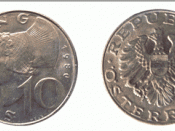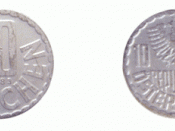Austria Once the center of power for the large Austro-Hungarian Empire, Austria was reduced to a small republic after its defeat in World War I. Following the capturing by Nazi Germany in 1938 and following job by the conquering associates, Austria's 1955 State Treaty declared the county "permanently Neutral" as a condition of Soviet military withdrawal. Neutrality has been called into question since the Soviet collapsed and Austria's increasing prominent role in European affairs. A wealthy country, Austria joined the European Union in 1955 and the euro financial system in 1999.
Austria with its high standard of living and well-developed market economy is closely tied to other EU economies, especially Germany's. Membership in the EU has drawn an influx of foreign investors attracted by Austria's access to the single European market. Austria has brought its total public division shortage down to 2.1% of GDP in 1999 and public debt- at 63.1%
of GDP in 1998 -more or less in line with the 60% of GDP required by the EMU's Maastricht criteria. To meet increased competition from both EU and Central European countries, Austria will need to call attention to knowledge -based divisions of the economy and deregulate the service sector. Growth, which slowed to 2% in 1999, probably will rebound to 2.8% in both 2000 and 2001.
Austria is located in Central Europe and north of Italy and Slovenia. Its Latitude and Longitude are 47 20 north and 13 20 east. Austria has a total of 83,858 sq km, 82,738 sq km of it is land and 1,120 is water. It borders Czech Republic, Germany, Hungary, Italy, Liechtenstein, Slovakia, Slovenia, and Switzerland. It has no oceans or seas because it is landlocked. In the western and southern areas are mostly mountains (Alps). In the eastern and northern areas it is flat or gently sloping. The lowest point of Austria is Nuesiedler See 115 m and its highest point is Grossglockner, which is 3,798 m.
Austria's natural resources are iron ore, oil, timber, magnetite, lead, coal, lignite, copper, and hydropower. Austria's land use is 17% arable land, 1% permanent crops, 23% permanent pastures, 39% forests and woodland, and 20% other. 40 sq km is irrigated land.
The population of Austria is 8,131,111 people. 17% are 0-14 (male 697,283; female 663,459), 68% are 15-64 (male 2,787,555;female 2,731,446)and 15% 65 and older (male 474,067; female 77,301). The population rate is 0.25%, Birth Rate is 9.9births/1,000 people, Death Rate 9.91 deaths/1,000 people. The net migration rate is 2.46 migrant(s)/1,000 people. The infant death rate is 4.5 deaths/1,000 live births. The life expectancy in Austria of total population is 77.68, males are 74.52 years and females are 80.99 years. The total fertility rate is 1.39 children born/woman. The different ethnic groups are Germans 98%, Croatian, Slovene, other ( Hungarians, Czechs, Slovaks, and Roma). The religious groups are Roman Catholic 78%, Protestant 5%, Muslim and other 17%. Austrians speak German.
The country's conventional long form is Republic of Austria, conventional short form is Austria, local long form is Republik Oesterreich and local short form is Oesterreich. The government of Austria is federal republic. The capital is Vienna. Austria has 9 divisions or states. They are Burgenland, Kaernten, Niederoesterreich, Oberoesterreich, Salzburg, Stiermark, Tirol, Vorarlberg, and Wien. October 26th is Austria's national holiday.
In Austria there are 3.726 million in use telephone and 83,000 more Integrated Services Digital Network connections. 2.31 million mobile phones are in use. There are 6.08 million radios in Austria. The radio stations in Austria are AM 1, FM 61 (plus several hundred repeaters), and shortwave 1. There are 51 (plus 920 repeaters ) television broadcast stations and 4.25 million televisions in use. In Austria there are 35 ISPs (Internet Service Providers).
Austria has 6,123 km (3,523 electrified) of railways. It also has 358 km of waterways. Austria has 777 km of crude oil and 840 km of natural gas in pipelines. The only ports or harbors Austria has are Linz, Vienna, Enns, and Krems. Austria also has 55 airports. There are a total of 22 airports with a paved runway. 12 are under 914 m, 3 are 914 to 1,523 m, 1 is 1,524 to 2,437 m, 5 are 2,438 to 3,047 m, 1 is over 3,047. There are a total of 33 airports with an unpaved runway. 29 are under 914m, and 4 are 914 to 1,523 m.
In the military 51,335 males reach military age a year. In Austria you can't join the military until you are 19 years of age. Military expenditures are 1.7 billion and percent of GDP is 1.2%.
Austria's industries are construction, machinery, vehicles and parts, food, chemicals, lumber and wood, processing, paper and paperboard, communications equipment, and tourism. The industrial production growth rate is 2.3%. The electricity production is 56.066 billion kilowatts. The source of the electricity is fossil fuel:31.46%, hydro:65.92%,no nuclear, and other:2.62%. 51.891 billion kilowatts are used. 10.5 billion kilowatts are exported and 10.25 billion kilowatts are imported. Austria agricultural products are grains, potatoes, sugar beets, wine, fruit, dairy products, cattle, pigs, poultry, and lumber. $62.9 billion worth is exported. Austria exports to EU 65% (Germany 36%, Italy 9%, France 5%), Switzerland 5%, Hungary 5%, and US 4.5%. The exporting supplies are machinery and equipment, chemicals, metal goods, paper products, iron and steel, textiles, and foodstuff. Austria imports $69.9 billion worth from EU 70% (Germany 42%, Italy 8 %, France 5%), US 5%, Hungary 3%, and Switzerland. $31.7 billion is external debt. 1 Austrian schilling (AS)=100groschen. 1 euro=0.9867 US dollars, 1austrian schilling=11.86 US dollars, but now the euro took over the Austrian schilling.
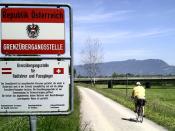
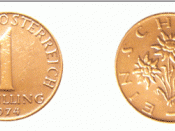
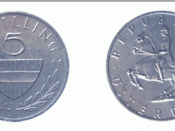
![Franz Ferd[inand] of Austria and wife; Countess Baillet de Latour (LOC)](https://s.writework.com/uploads/11/117386/franz-ferd-inand-austria-and-wife-countess-baillet-latour-lo-thumb.jpg)
